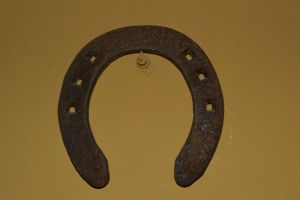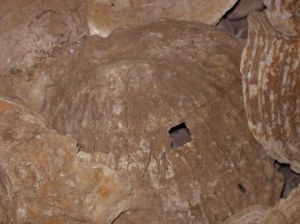|
In 1997 the Gibraltar Museum undertook an urban excavation at Casemate’s Square at the entrance to Main Street, Gibraltar. Casemate’s was a port area hundreds of years ago (details and discussion of the excavation are in Finlayson and Finlayson, 1999). The excavation turned up a great deal of very interesting material including many large oysters (Ostrea edulis Linnaeus, 1758) from the 16th century levels. Some of these oysters are much larger than those found around Gibraltar’s shores now and fit the description for O. edulis form hippopus Lamarck, 1819. A striking feature of many of these oysters is the presence of a square perforation (Photo 1) that Professor Clive Finlayson, Dr. Darren Fa (both from the Gibraltar Museum) and myself hypothesized were made to ease the opening of the shell.We thought this might be an explanation because perforations were located mostly in the area of the adductor muscle. Knife marks on the inside of many shells suggests people were eating the oysters.We know oysters were popular in the area, as in many other Mediterranean areas (Poppe and Goto, 1993), with extensive oyster beds in the Bay of Gibraltar, up until about 100 years ago (Finlayson and Finlayson, 1999). With so much other research to occupy us, the case of the perforated oysters took a place (among many others!) on the backburner.Then, on a recent visit to a restaurant in nearby Los Barrios, Spain, I saw old horseshoes (Photo 2) nailed onto a wall, forming part of a collection of old farm implements. It struck me immediately that the holes made on these were similar in shape to the ones on our oysters.Although the horseshoes are not contemporaneous to the oysters, it made me think that perhaps the holes were made in the shells as a means of nailing the shells onto something. Maybe they were used as roof tiles, or for decoration. I’ve not come across any mention of this use locally, nor in the literature generally (but I’ve not done an exhaustive search). Has anyone come across shells perforated in a similar way to the Gibraltar oysters, and if so, why they were perforated? Finlayson C, Finlayson G. 1999. Gibraltar at the End of the Millenium. Gibraltar: Aquila. Poppe GT, Goto Y. 1993. European Seashells,Vol. II.Wiesbaden: Hemmen. |
Fig 1 A horseshoe forming part of a display of old farm implements in a restaurant in Los Barrios, Spain. The horseshoe is about 10cm across at the widest part. (Photo Alex Menez)
Fig 2 One of the Gibraltar perforated oysters from the Casemate’s Square excavation. The cut-out area is just over 1cm across. (Photo Alex Menez) |
Oysters and Horseshoes
Issue
10
Page
19


